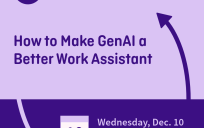As technology continues to advance, citizens are offered an increasingly wide range of devices, platforms and applications to improve their daily lives. Many service providers, particularly in the private sector, are leveraging these new tools and technologies to provide robust, multichannel services.
But while these advancements are improving many processes, Granicus Chief Operating Officer Scott Macfee explained that these innovations can also present challenges to the public sector.
“Government agencies feel immense pressure to provide a seamless digital experience for citizens,” Macfee said. “As more people become accustomed to private sector delivery speed, integration of services, easy check outs and attentive customer service, a new normal of heightened expectations is firmly set in place.”
To meet this new bar, Macfee impressed the need to take a strategic approach to analyzing, streamlining and updating citizens’ user experiences. Granicus offers innovative solutions for communications, content management, and meeting and agenda management that make that possible. But before agencies deploy new digital solutions, Macfee said they have to understand the current state of their customer journey by mapping the end-to-end citizen experience.
“Building a citizen journey map helps tell the full story of the citizen experience and answers important questions about the citizen’s motivations and needs,” he explained. “Identifying where your audience interacts with your organization will help you pinpoint opportunities to enhance the experience, thereby increasing loyalty and satisfaction.”
To start a journey map, Macfee said to first gather team members from across the organization who interact with citizens on a day-to-day basis. With the right employees working together, you can ensure you know about every touchpoint that a user might have with your organization. You’ll also learn where each person sees recurrent problems or executes redundant processes.
Next, Macfee encouraged agencies to seek data. “Citizen journey mapping is all about the data. What resources can help inform your team about citizen touchpoints? A few examples of important data to gather include website analytics, social mentions, and focus groups or survey results,” he said.
With these two steps complete, you can create a map of the end-to-end citizen experience. That map becomes a tool for analysis. You’ll notice common themes and will likely be able to group experiences by types of citizen “personas.” With these personas in mind, you can evaluate each touchpoint or step in a citizen process to identify what is currently meeting expectations, what isn’t, and how pain or pinch points can be addressed as opportunities to improve service.
In this step, it’s helpful to include outside perspectives to validate your findings and offer solutions or ways to improve. “Granicus’ Digital Engagement Services (DES) team is made up of experts that work with government agencies every day to complete this exercise,” Macfee said. “The DES team operates as an extension of the team, working alongside an agency, and can be an important outside perspective throughout the exercise.”
When your mapping exercise is complete, present findings to your agency’s leaders and gain support for efforts to enhance the citizen experience. In many cases, your recommendation will be to invest in better technologies that improve specific touchpoints. However, it’s important to continue thinking of the citizen journey as a holistic experience that should be built or improved with the entire journey in mind. To avoid adding one-off solutions that complicate, rather than streamline, the citizen experience, make sure you identify integrated solutions that fit your current organization, constituent services and processes.
“We understand the importance of providing a seamless digital experience for citizens,” Macfee said. “Granicus is committed to providing the first integrated platform that connects multiple digital services and experiences. We offer an innovative legislative management solution and an expansive citizen engagement tool that solves today’s objectives while anticipating future needs of a modern digital government.”
With the right solutions in place, agencies can create a streamlined customer experience that presents citizens with modern, intuitive services at every stage of interaction. Communication can remain consistent across multiple channels and can be quickly updated as needed. Plus, agency workers will have more time to dedicate to mission-critical tasks, as modern digital platforms like Granicus automate many redundant manual service tasks.
The benefits of understanding your customer journey and applying integrated digital solutions to meet citizen expectations are endless. But most important is that government agencies that understand those journeys are best equipped to deliver on their mission of serving citizens.






Leave a Reply
You must be logged in to post a comment.